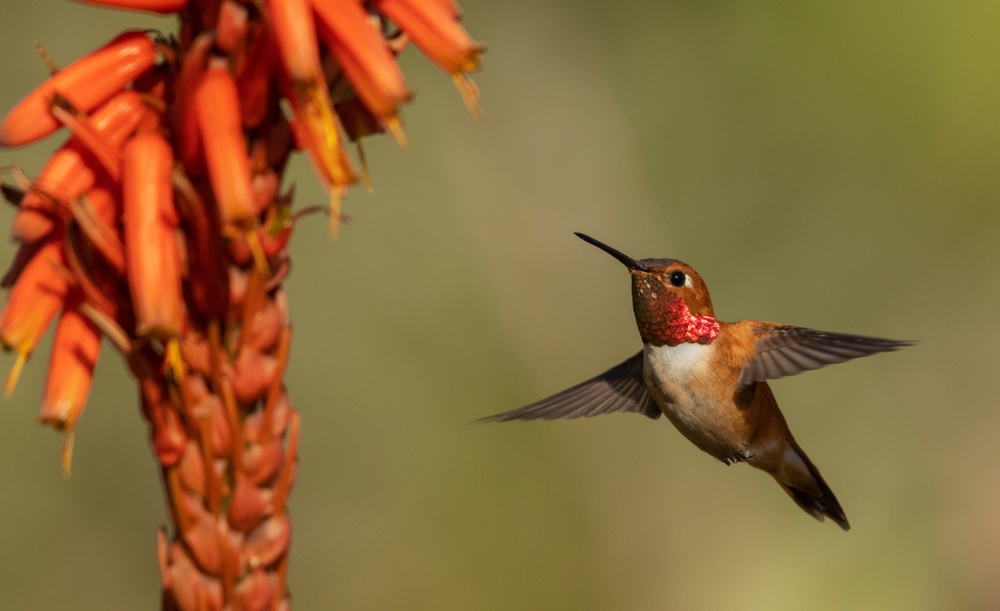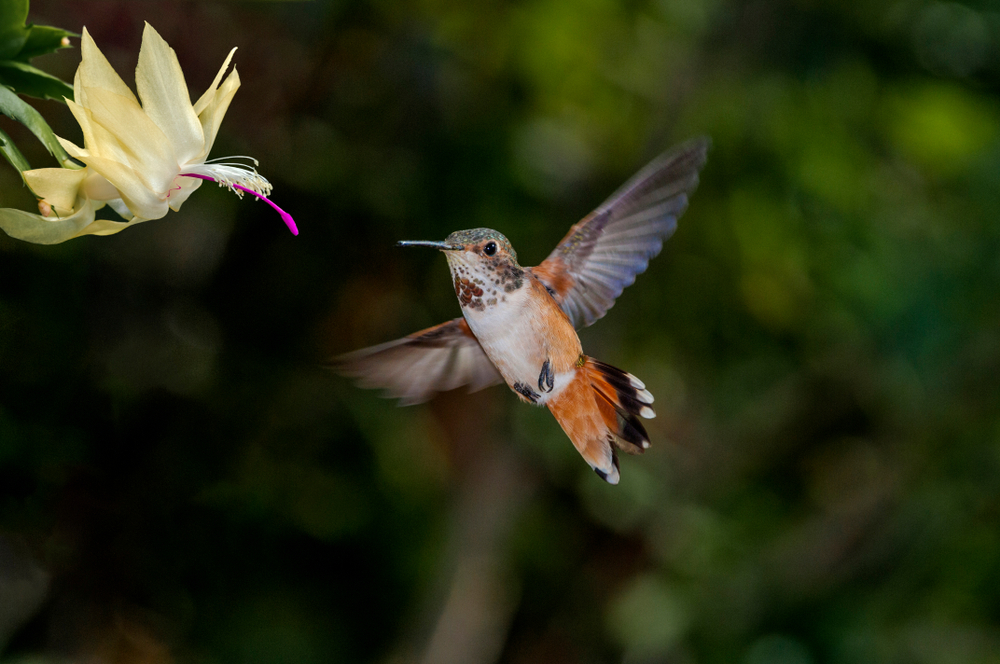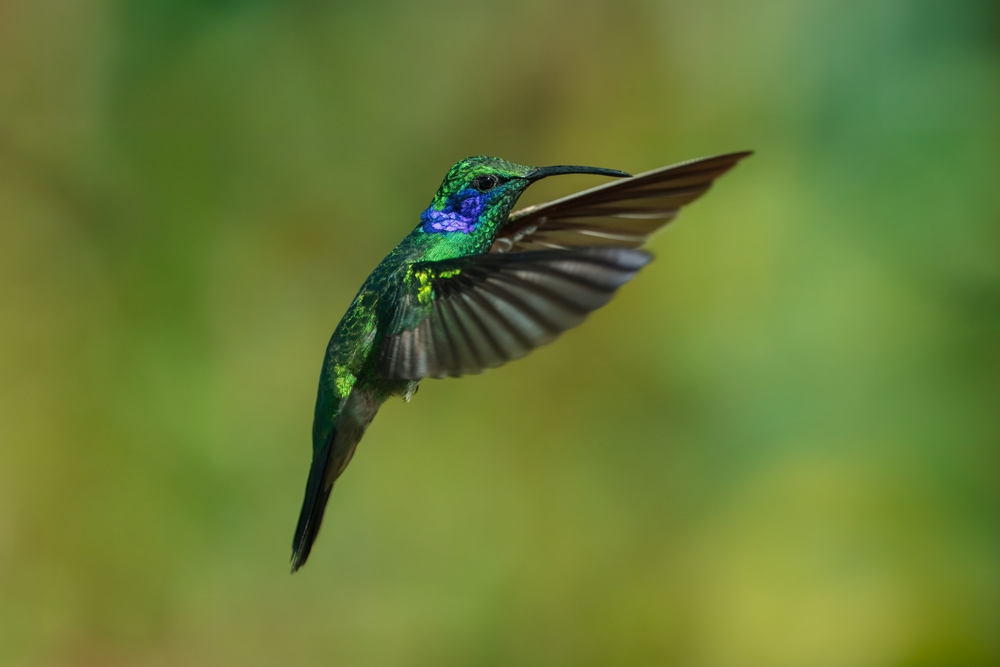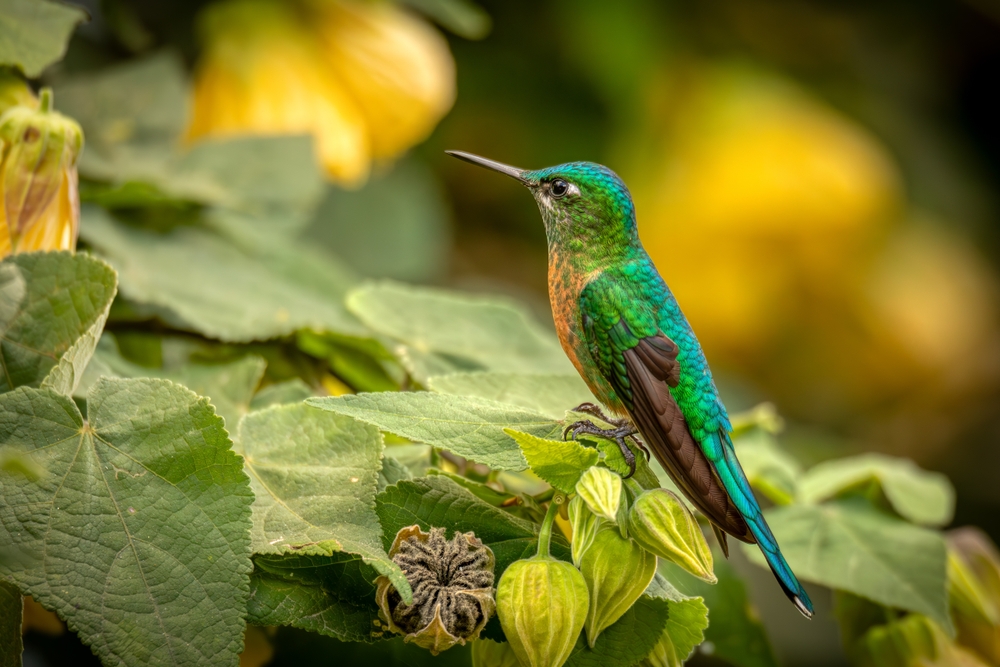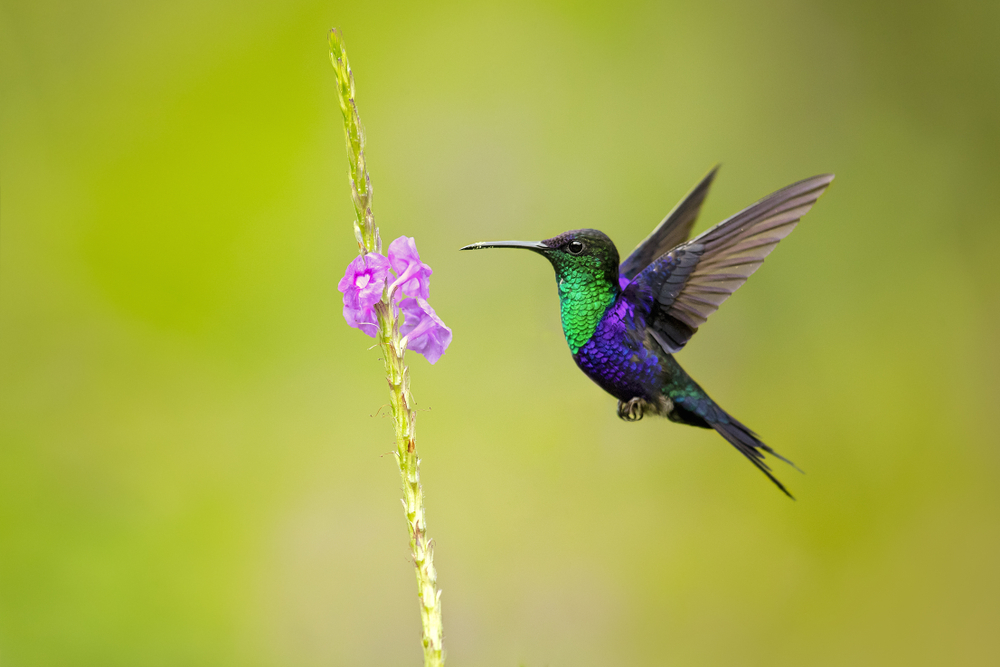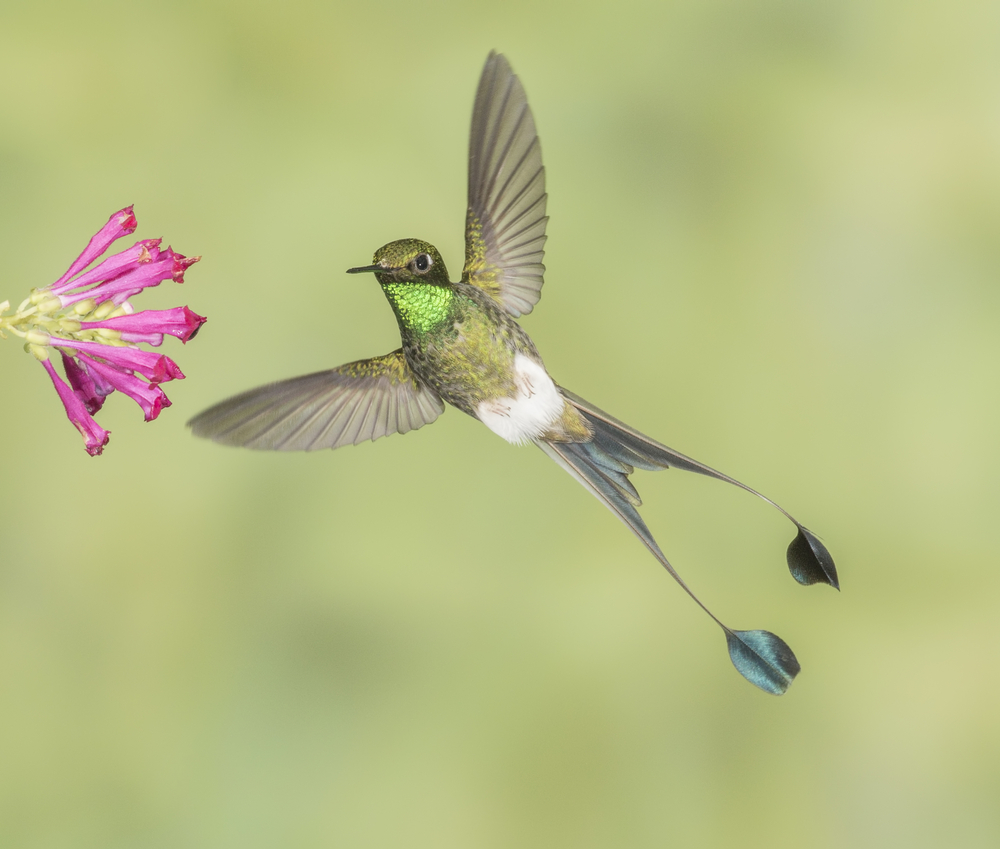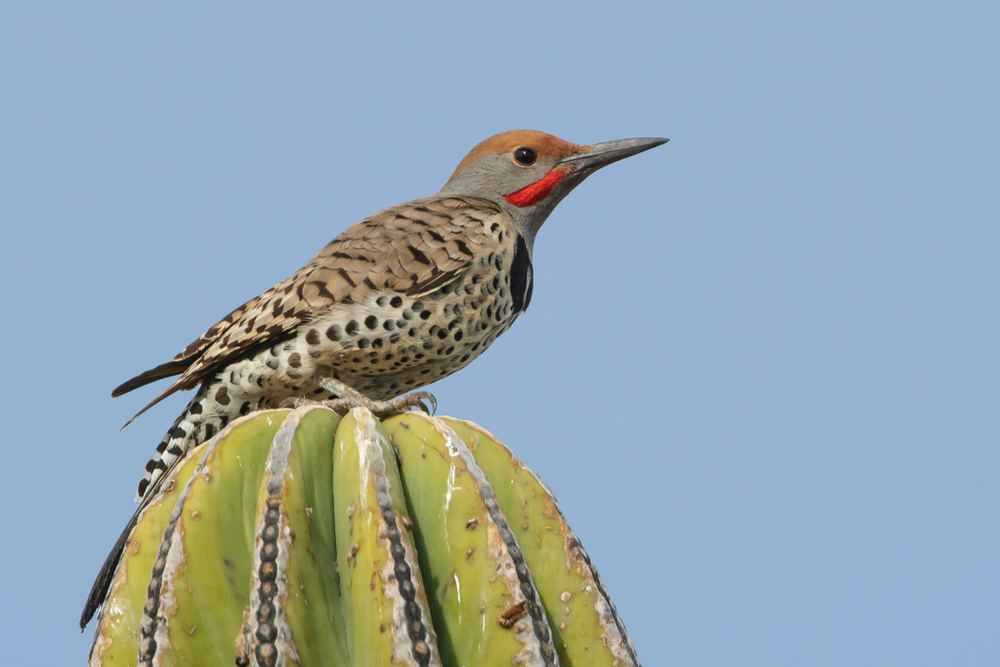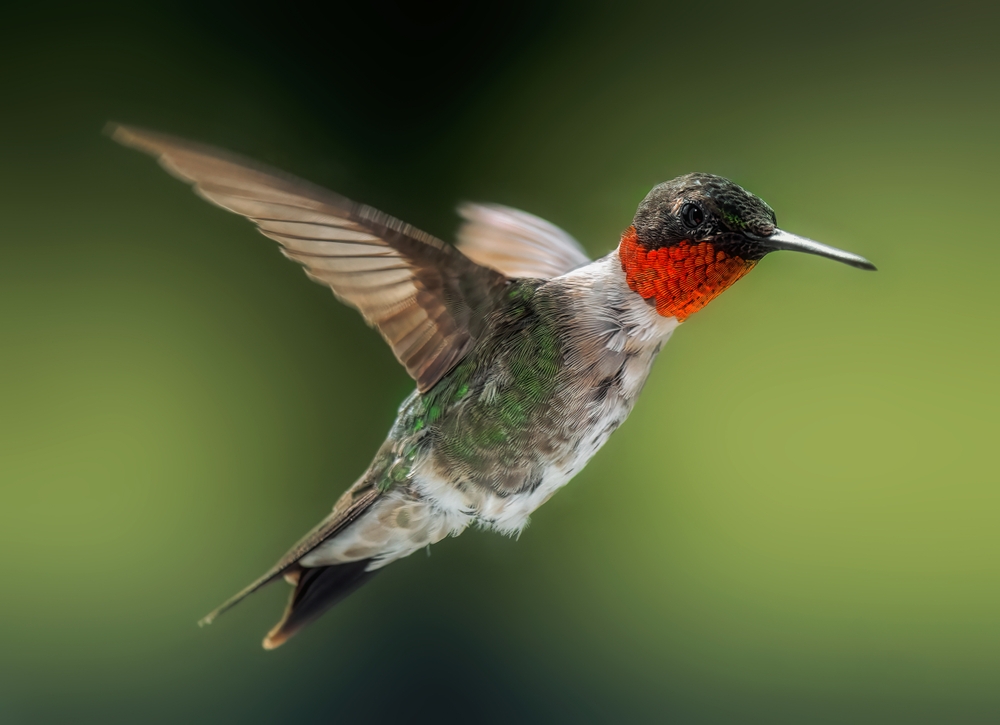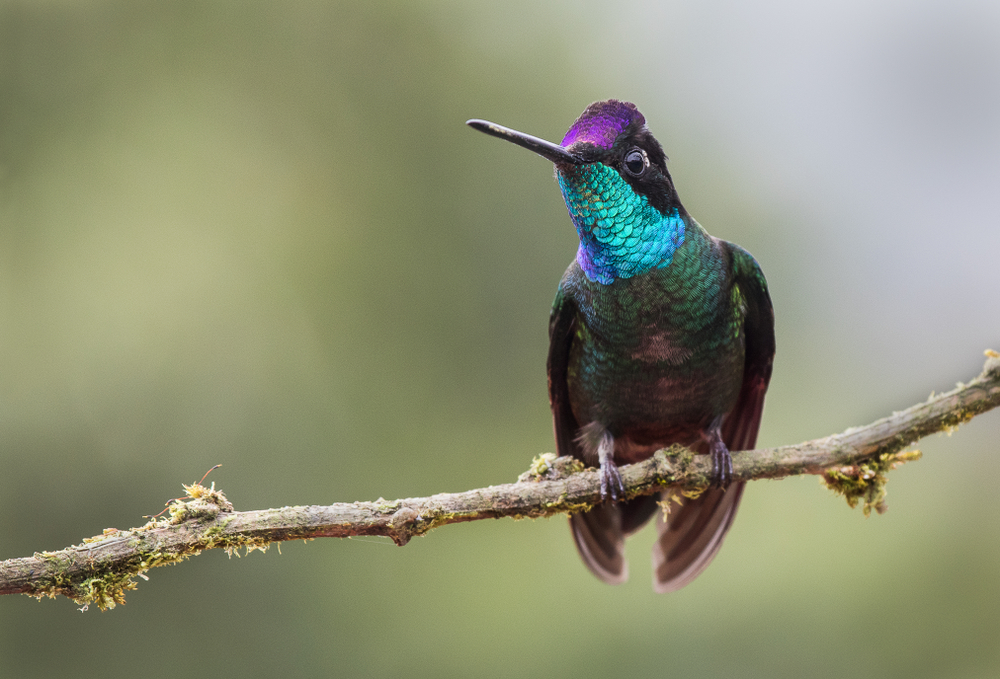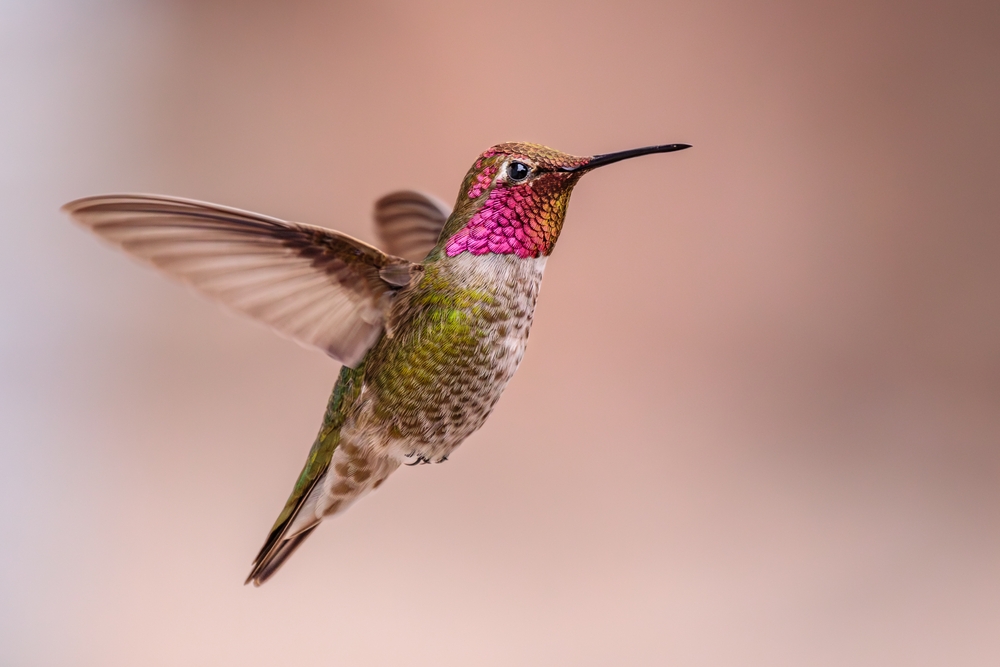The Rufous Hummingbird (Selasphorus rufus) is closely related to the Allen’s Hummingbird (Selasphorus sasin). Both share rufous coloring, but Allen’s has more green on the back and a narrower range along the Pacific Coast.
About
The Rufous Hummingbird (Selasphorus rufus) is a feisty and resilient member of the family Trochilidae, renowned for its fiery plumage, aggressive nature, and extraordinary migration. Breeding in the northwestern United States, western Canada, and as far north as southern Alaska, this tiny bird undertakes one of the longest migrations of any hummingbird relative to body size, traveling up to 3,900 miles (6,300 km) to winter in Mexico.
Measuring just 7–9 cm (2.8–3.5 in) in length and weighing 2–5 grams, the Rufous Hummingbird is small but striking. Males are especially brilliant, with gleaming orange-red plumage, a radiant iridescent red gorget, and a rufous tail. Females and immatures are less vivid, showing greenish backs with rufous flanks and tails accented by white tips. Despite their tiny size, these hummingbirds are highly territorial and will aggressively chase away rivals, even those much larger than themselves.
The Rufous Hummingbird feeds primarily on nectar from wildflowers such as columbine, paintbrush, and penstemon, as well as from garden blooms and hummingbird feeders. It also consumes small insects and spiders for protein, which are especially important during migration and nesting. Agile and relentless, it visits hundreds of flowers each day to sustain its rapid metabolism.
During breeding season, males perform spectacular courtship displays, diving steeply from the air and producing buzzing sounds with their wings and tails to attract females. After mating, females alone build small, cup-shaped nests made of moss, lichens, and spider silk, where they lay two white eggs and raise the chicks without male assistance.
Though currently widespread, Rufous Hummingbirds face population declines due to habitat loss, climate change, and shifts in flower bloom times along their migratory routes. Still, their fiery colors, fierce spirit, and epic migrations make them one of the most remarkable hummingbirds in North America.
Physical Characteristics
Plumage:
The Rufous Hummingbird (Selasphorus rufus) is one of the most fiery and recognizable hummingbirds in North America.
-
Male: Brilliant iridescent orange-red gorget (throat patch), with rufous (reddish-orange) back, sides, and tail. Some males show green flecking on the crown or back.
-
Female: Green upperparts, whitish underparts with buffy flanks, and a rufous tail with green central feathers and white tips. The throat is whitish with variable rufous or orange spotting, but lacking the solid gorget of males.
Head:
Males feature a dazzling, iridescent gorget that glows fiery red in the sunlight. The bill is short, straight, and black, perfectly adapted for nectar feeding.
Body:
Small, compact, and muscular—built for long-distance migration. Their fiery rufous plumage makes them one of the easiest hummingbirds to identify in North America.
Size:
-
Length: 2.8–3.5 in (7–9 cm)
-
Wingspan: 4.3 in (11 cm)
-
Weight: 0.1–0.2 oz (2.5–4.5 g)
Feet & Tail:
Feet are tiny and used mostly for perching. The tail is rufous with pointed tips in males; females have green-centered tails with rufous bases and white tips.
Flight Style:
Wingbeats average 50–55 per second, producing the familiar humming sound. Males perform steep J-shaped or U-shaped dive displays during courtship, accompanied by buzzing and whistling sounds created by their tail feathers.
The Rufous Hummingbird’s fiery rufous body, glowing orange-red gorget, and pugnacious nature make it one of the most striking and unmistakable hummingbirds in North America.
Reproduction
Breeding Season:
Rufous Hummingbirds breed in the spring and summer (generally April through July) across the northwestern U.S., western Canada, and southern Alaska. Their nesting period coincides with the peak bloom of wildflowers in these regions.
Courtship:
-
Males perform dramatic J-shaped or U-shaped aerial dives, producing a distinctive buzzing and whistling sound with their wings and tail feathers.
-
They also hover in front of females, flashing their fiery orange-red gorget in direct sunlight.
-
Males aggressively defend their display territories but, as with most hummingbirds, do not assist with nesting or raising young after mating.
Nesting:
-
The female alone builds the nest, usually 6–30 ft (2–9 m) high, on tree branches, shrubs, or even ferns.
-
The nest is tiny and cup-shaped, about 1.5 in (4 cm) across, constructed of plant down, moss, and spider silk, camouflaged with lichens.
-
The elastic structure allows the nest to expand as chicks grow.
Eggs:
-
A clutch typically contains 2 small white eggs, each about the size of a pea (~0.5 in / 1.3 cm long).
Incubation:
-
Lasts 15 to 17 days.
-
Only the female incubates the eggs.
Chick Development:
-
Hatchlings are altricial (blind, featherless, and helpless).
-
The female feeds them regurgitated nectar and small insects.
-
Nestlings fledge at about 18 to 23 days, though they may stay near the female for another week while learning to forage.
Maturity:
-
Juveniles quickly develop independence by late summer, often joining southward migrations soon after fledging.
-
Sexual maturity is reached at about 1 year of age, when they are capable of breeding.
The Rufous Hummingbird’s reproductive cycle is distinguished by its northern breeding range, making it one of the few hummingbirds to nest as far north as Alaska.
Lifespan
In the Wild:
Rufous Hummingbirds typically live 3 to 5 years in their western North American range. As with most hummingbirds, survival is lowest in the first year due to migration hazards, predation, and environmental stress.
In Captivity:
Rarely kept outside of rehabilitation or research, but in protected conditions they may reach 7 to 8 years.
Record Lifespan:
The oldest recorded Rufous Hummingbird, documented through banding studies, lived at least 8 years and 11 months, an impressive age for such a tiny bird.
Threats to Longevity:
-
Predation: Vulnerable to hawks, kestrels, jays, snakes, praying mantises, and domestic cats.
-
Migration Hazards: They travel one of the longest migration routes of any hummingbird, from Alaska/Canada to Mexico—exposing them to storms, exhaustion, and food scarcity.
-
Climate Change: Alters flowering schedules, disrupting the synchronization of nectar sources with migration.
-
Collisions: Window strikes and entanglement in spider webs or human debris are frequent risks.
Despite these challenges, Rufous Hummingbirds are remarkably resilient and are considered one of the toughest and farthest-migrating hummingbirds in the world.
Eating Habits
Diet:
The Rufous Hummingbird maintains a high-energy diet consisting of:
-
Nectar: Primary fuel, drawn from wildflowers such as columbine, currant, penstemon, and scarlet gilia, as well as from backyard feeders.
-
Insects & Spiders: Tiny flies, gnats, aphids, and spiders provide essential protein, especially during breeding and chick-rearing.
-
Sap: Occasionally visits sapsucker wells to drink tree sap and feed on trapped insects.
Foraging Behavior:
-
Uses its long extendable tongue to lap nectar at a rate of 10–13 licks per second.
-
Known for its aggressive territoriality, often chasing away not only other hummingbirds but also bees and larger birds from flower patches and feeders.
-
Follows trapline foraging during migration, visiting flowers and feeders along a repeated route.
-
Also captures insects midair (hawking) or gleans them from foliage and spider webs.
Feeding Adaptations:
-
High metabolism requires feeding almost constantly, consuming up to half its body weight in nectar and insects daily.
-
Can enter torpor on cold nights, lowering metabolism drastically to conserve energy.
-
Strong memory enables it to track flowering cycles and return to the same feeding areas during migration.
Role in Ecosystem:
The Rufous Hummingbird is a vital pollinator of wildflowers in mountain meadows, forests, and coastal regions. Its long migrations also make it an important pollinator across a broad range of habitats.
The Rufous Hummingbird’s fiery aggression, trapline feeding, and extraordinary endurance highlight its role as both a pollinator and one of the toughest hummingbirds in the Americas.
Uniqueness
Longest Migration Relative to Size:
The Rufous Hummingbird has one of the longest migrations of any bird, traveling up to 4,000 miles (6,400 km) one way between Alaska/Canada and Mexico. For its tiny size, this is among the greatest migrations in the animal kingdom.
Fiery Plumage:
Males are among the most distinctive North American hummingbirds, with brilliant orange-red gorgets and rufous backs and tails, earning them a reputation as the “firebirds” of the hummingbird world.
Extreme Aggression:
Despite their small size, Rufous Hummingbirds are fierce and territorial, often dominating feeders and driving away much larger birds. They are considered one of the most aggressive hummingbird species.
Cold-Climate Breeders:
They are one of the northernmost breeding hummingbirds, nesting as far north as southern Alaska—far beyond the range of most hummingbirds.
Memory and Site Fidelity:
Rufous Hummingbirds have exceptional memory, often returning to the exact same feeders, gardens, or natural flower patches year after year along their migratory route.
Symbol of Endurance:
Their fiery plumage, toughness, and epic migrations make them a symbol of endurance and adaptability, surviving from subarctic forests to tropical highlands.
The Rufous Hummingbird’s long-distance migration, fiery plumage, and bold personality make it one of the most unique and celebrated hummingbirds in the world.
Be the First to Share Photos of This Species.
FAQ’s
1. What is the closest species to the Rufous Hummingbird?
2. How does the Rufous Hummingbird compare to other hummingbirds?
It is smaller than many hummingbirds but far more aggressive, often dominating feeders and defending flowers fiercely. It is also unique for nesting as far north as Alaska and making the longest migration relative to body size of any bird.
3. What national parks provide the best opportunities to see a Rufous Hummingbird?
They are best seen during breeding and migration in Olympic National Park (Washington), Denali National Park (Alaska), and Glacier National Park (Montana), where wildflower meadows attract them in summer.



































































